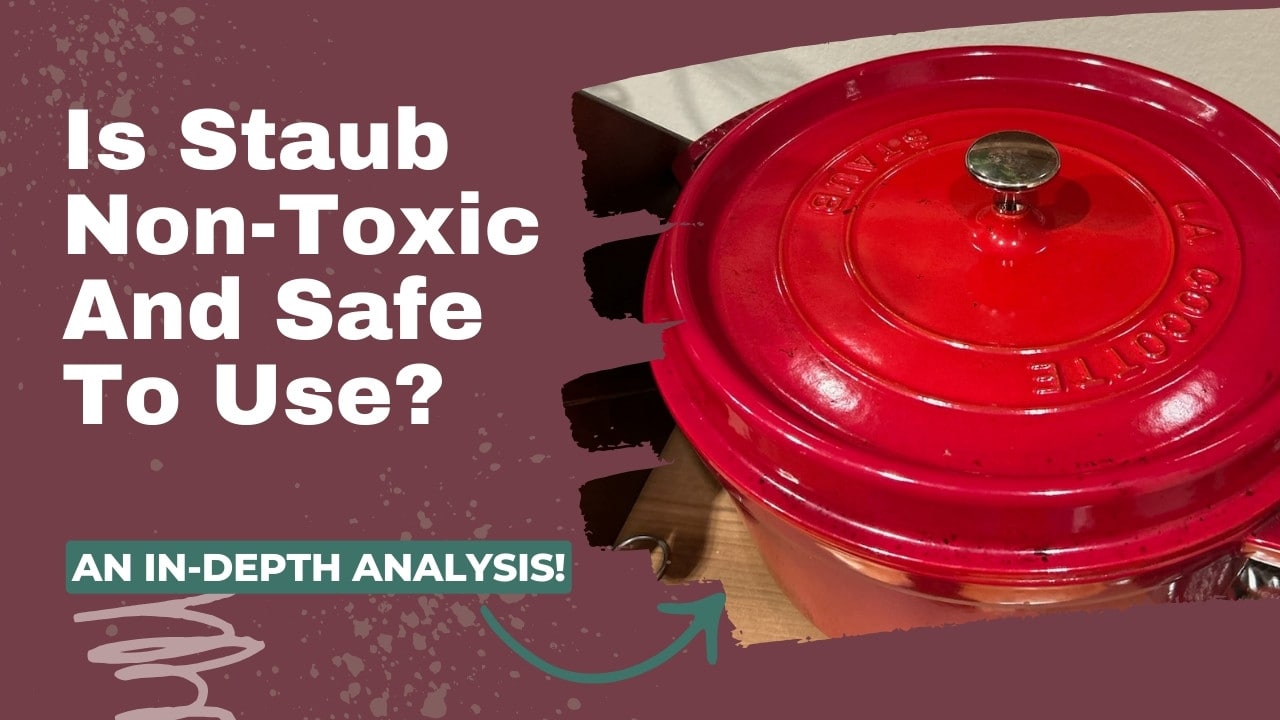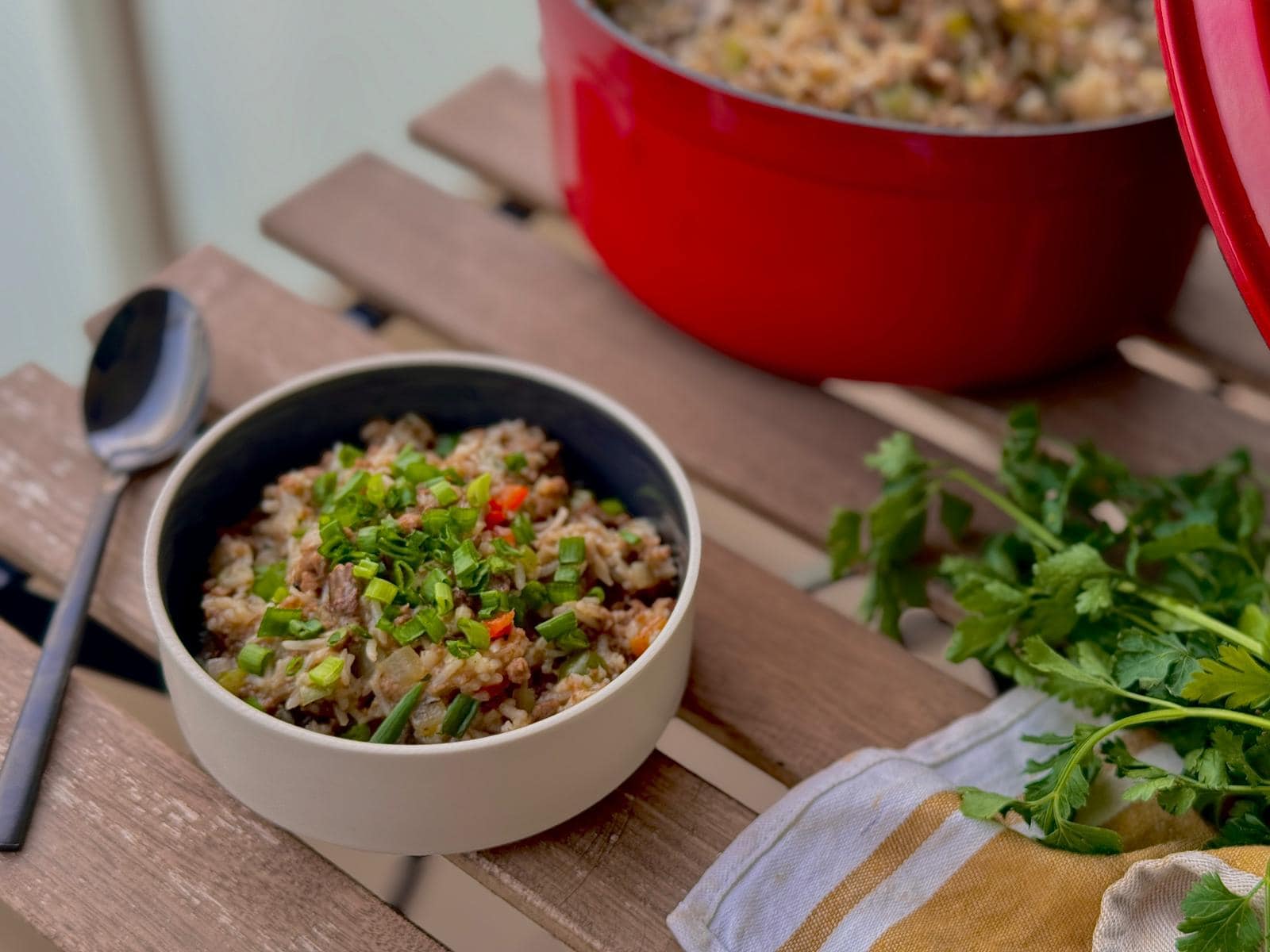Although it’s a comparatively new brand, Staub has quickly risen to the top of the pile when it comes to enameled cast iron. To find out about Staub’s safety compliance, we delved into online resources and reached out to Staub USA for a statement, which I will include below.
To get right to the point, Staub complies with all necessary safety regulations in the US and the EU. I believe it is lead-free and one of the very best non-toxic Dutch ovens.
At a Glance: Is Staub Safe to Use?
From our extensive research and testing of the Staub Enameled Coccote, we believe the following to be true about the product:
What Chemicals are in a Staub Cocotte?
To start this out, I have to point out that just about everything is made of “chemicals” of some form. Not all chemicals are harmful – but when we discuss cookware, we want to know about harmful chemicals that can leach into your food during cooking and cause adverse health effects. These are chemicals like PFAs and PFOA and heavy metals like lead and cadmium.
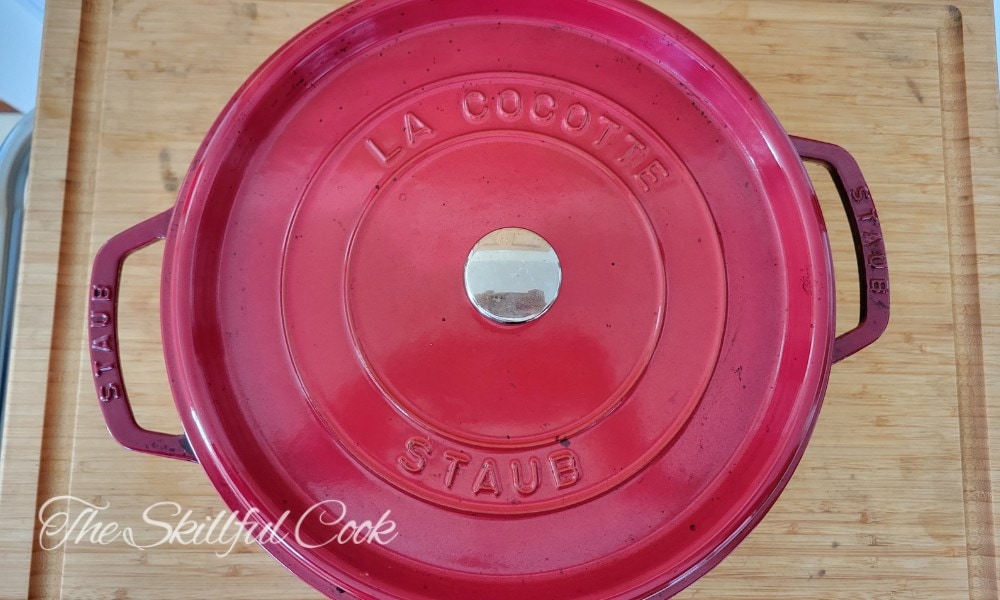
Staub’s enamel cast iron cocotte doesn’t contain PFAs, PFOA, GenX, or PTFE. These are “forever chemicals” used to make nonstick coatings. The porcelain enamel coating on a Staub cocotte is made from powdered glass fired at high temperatures to fuse it to the cast iron. It creates a naturally semi-nonstick, nonreactive surface that doesn’t require any additional chemical coatings.
Regulations that Affect Staub
Staub’s enamel cast iron is made in France, so it falls under strict EU regulations. These products are assessed and screened according to the Ceramics FCM Directive 84/500/EEC, which concerns the migration of lead and cadmium from cookware to food.
In the US, porcelain enamel cast iron pieces need to be compliant with California Prop 65, which establishes whether or not a product contains threshold levels of hazardous chemicals or metals.
California AB1200, which went into effect in 2023, requires cookware manufacturers to declare added hazardous chemicals or metals used in their products and restricts deceptive health-related advertising. Zwilling, the parent company of Staub, does not declare any hazardous chemicals under AB1200 in its cookware.
In short, Staub is compliant with both California and EU regulations.
Does a Staub Cocotte Have Lead or Cadmium?
Historically, lead and cadmium were used in making ceramic glazes as a color enhancer and to give enamel its shiny surface. This practice has fallen out of favor thanks to strict regulations, but some cookware and dinnerware companies still use cadmium or other metals in their products, claiming that it is only a problem if it can leach from the cookware into your food.
Not Staub.
Staub calls its cookware “lead-free” and not just “lead-safe,” meaning that lead is not used in the manufacturing of its products. Modern Staub enameled cast iron should be completely non-toxic and safe to cook with, even for long periods of slow cooking.
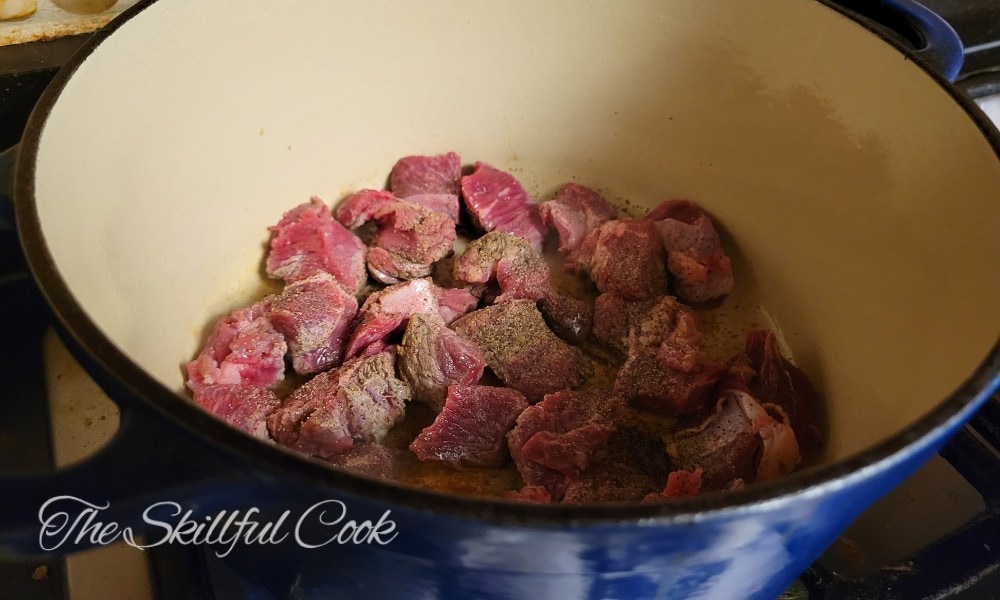
However, it’s important to realize that lead-restricting regulations are fairly new. Vintage Staub pieces from the 70s could contain leachable lead and cadmium. Picking up a vintage piece of cast iron for a bargain is great, but for your safety, I recommend getting it tested for lead at a lab, or at least testing it yourself at home.
See our guide on Testing Dutch Ovens For Lead At Home.
Staub and Third-Party Testing: Can They Be Trusted?
In recent years, Staub’s parent company, Zwilling J.A. Henckels has been more transparent about its sustainability, safety, and regulation compliance than many of its competitors.
At The Skillful Cook, our team reached out to Staub (ZwillingUSA) on social media, and this is what they had to say about their third-party testing:
“Zwilling as a company do third party certify labs test for all of our products for harmful materials. We cannot release the findings as they are proprietary, but we can assure you that our products meet all legal regulations and are 100% safe when used properly. And are California Proposition 65 compliant.
Staub is Cadmium Free, Lead-Free, PFOA Free, PTFE Free and California Proposition 65 compliant.”
– Zwilling USA
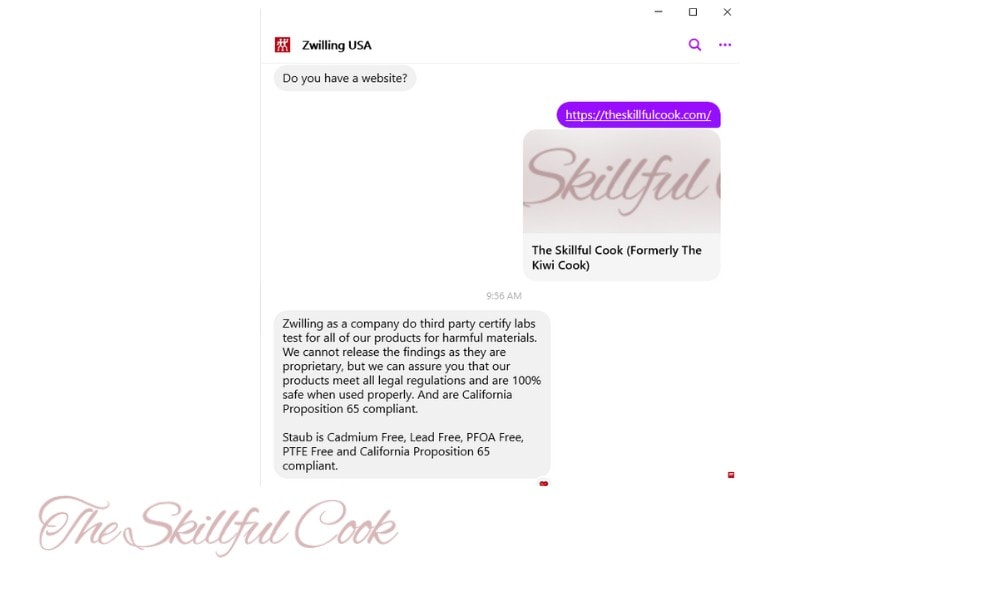
Transparency is incredibly valuable to a customer when it comes to safety testing, and yet, many brands seem to skirt around the issue. Staub is one of the rare brands that at least communicates with its customers about the issue, even if it falls short of brands like
We reached out to some of Staub’s closest competitors for a statement on their compliance – on social media and multiple times by email – and did not receive a response.
Is It Safe for Acidic Foods?
A Staub, like other porcelain enamel Dutch ovens, is great for cooking acidic foods, like a tomato-based stew. The enamel is highly acid-resistant, so you can deglaze a Staub cocotte with wine or vinegar without concern. Enameled pots do not need to be seasoned, so you won’t have to worry about stripping polymerized oil with acidic foods.
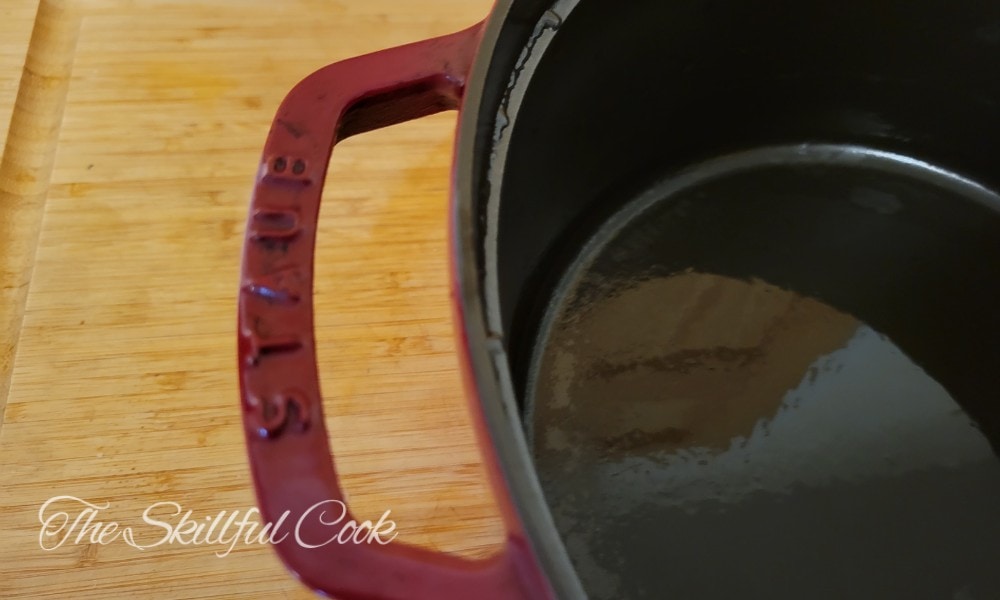
This acid resistance also means that Staub will not transfer iron to your food as long as the enamel is intact.
What if the Enamel Chips?
So, by now, you should feel a bit more comfortable about how nontoxic Staub is – but what if the enamel chips?
Staub doesn’t reveal exactly what’s in the recipe for its enamel coating, besides a bit of quartz for texture. It’s not likely to hurt you, but we recommend avoiding ingesting chips of the enamel if you can help it. Biting down on a chip of enamel could cause mouth or dental injury.
Luckily, Staub’s porcelain enamel is triple-coated and very durable, so chipping is unlikely if you use the pan carefully. But chipping can occur if you drop the pan, heat it empty for too long, or use metal utensils on the surface.
If there are areas where the enamel has been chipped, the raw cast iron will be exposed. Raw cast iron will react with acidic foods and transfer iron to food, and is prone to rust.
To be on the safe side, I recommend replacing a cocotte with chipped enamel. Luckily, Staub offers a lifetime warranty. If the damage is due to a manufacturing defect and not user error, you will likely get a replacement.
Is the Zwilling/Staub Company Environmentally Conscious?
Staub was acquired in 2008 by Zwilling, a major cookware company that has made extensive efforts to be environmentally conscious. Zwilling is FSC-certified, and the packaging for many of its products is recyclable or biodegradable, according to its website. It has pledged to be climate-neutral by 2030. It also has a water treatment plant installed at its Indian production site to lessen its impact on its immediate environment.
Staub does not produce products with PTFE or synthetic polymer coatings, but Zwilling continues to use them on its nonstick products.
Conclusion: What is the Safest Enameled Dutch Oven?
When customers are looking into Staub, it’s most likely because they’re looking into buying their signature Dutch oven. Well, we did a product round-up on nontoxic Dutch ovens, and the Staub came out on top!
Staub’s enameled cast iron skillets are made in the same factory and have the same safety features as the cocotte, so I recommend it with confidence as a non-toxic fry pan.
Thinking of buying the Staub Enamelled Coccote? Read our extensive review of the Staub Dutch Oven before you make a buying decision!
If you have any more questions about Staub’s safety, please drop them below, and I’ll get back to you.

